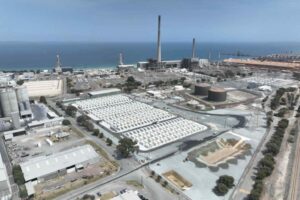I’m preparing for a trip to your fine nation later this month to speak at the National Energy Efficiency Conference in Melbourne, so I’ve been reading up on Australian energy policy debate. It’s been fascinating.
I still have a lot to learn about your energy system, but so far one thing stands out: the discussion in Australia seems overly focused on the transition underway on the supply side of the market.
Don’t get me wrong – the decarbonisation of the world’s energy supply is crucial, and you won’t find a stronger advocate for renewables than me. Way back in the 1990s, I installed many small, remote PV and wind systems with my own two hands, and trained others to do the same.
More recently I ran two of California’s signature renewables programs – the California Solar Initiative and Self-Generation Incentive Program.
However, focusing solely on the move to low carbon generation without pursuing demand side opportunities in an ambitious, systematic way actually makes the transition harder.
Energy efficiency and demand response are just as important to the energy transition as renewables are, as we’ve learnt in California. Today’s technology helps us utilise energy smartly; and indeed the least expensive and cleanest unit of energy is the one not needed at all.
Energy efficiency has been a central contributor to California’s energy mix since the 1970s.∗ Efficiency is responsible for an annual reduction in statewide electric consumption of 90 TWh (Figure 1), the equivalent of 30 percent of the state’s current electricity consumption and enough to power around eight million households.
California’s per capita electricity use has remained flat since the mid-1970s, despite a fourfold increase in real economic output, larger homes and the proliferation of consumer appliances and electronics.
Since 2000, the state’s overall carbon emissions are down 8 percent while its economy has grown by 28 percent. California’s deliberate, consistent focus on energy efficiency has played an important role in these successes.
Figure 1: California Electricity Savings

Figure 2: Historical and Projected Per Capita Electricity Consumption

Going forward, the California legislature and Governor Brown have established a goal to double the flow of efficiency savings by 2030. The estimated impacts of this doubling effort are shown in Figure 2. Achieving the goal will see per capita consumption decline around 25 percent by 2030. California’s suite of energy efficiency activities includes:
- Building energy efficiency standards. The 2019 Standards update will require residential new construction to have advanced building shells, high-performing water heating and mechanical systems, all-LED lighting and, for the first time, sufficient self-generation (typically PV) to offset all electric load. Incremental costs are shown to be cost-effective.
- Appliance efficiency standards. California has explicit authority to develop efficiency standards where national standards do not exist. Recent standards adopted include general service LEDs, computers, and battery chargers. Many appliance standards are currently in development (e.g. industrial fans and blowers, certain compressors and pumps, and room air conditioners).
- Existing building performance. Existing buildings are an ongoing, primary focus for achieving the doubling goal. The Energy Commission’s Existing Building Energy Efficiency Action Plan is updated every three years and is organised around five goals: government leadership; data for improved decisions; workforce development; market valuation of efficiency; and financing.
- Efficiency-focused programs, grants and loans. California invests almost $2 billion annually in incentives, financing and technical support programs focused on energy efficiency.
- Multifamily and commercial benchmarking and disclosure. A time-certain benchmarking requirement commences in mid-2018, with public disclosure of benchmark information after one year. Visibility of relative building performance will stimulate retrofits statewide, and the information developed will enable improved policies and programs in pursuit of the energy efficiency doubling goal.
- Emphasis on disadvantaged communities. Efficiency must be accessible to all citizens. Each efficiency initiative includes special attention to low-income residents and communities.
- Research, development and demonstration. California funds $150 million per year in efficiency-related research, covering a broad array of topics based on each two-year investment plan.
- Data access and modern analytics. The future grid will depend on highly localised and temporal understanding of energy patterns. Modernisation of data collection and analytical systems permeates all of California’s efforts in energy efficiency.
Energy efficiency reduces the need for new generation (both fossil and renewable), increases electric system resilience and lowers the cost of all energy supply scenarios – while directly reducing greenhouse gas emissions. In short, efficiency is critical to a successful clean energy transformation, for three big reasons:
Modern energy management complements renewable energy supply
Highly efficient products and practices increasingly bundle with digital communication and control features to support demand-side responsiveness to the momentary needs of the grid. Good design of buildings and industrial processes, together with advanced energy management systems, can provide both beautifully tailored performance for customers and valuable and much-needed grid services that aid seamless incorporation of renewable energy into the supply mix.
Energy efficiency optimises the distribution grid
Energy efficiency frees capacity in the distribution grid, allowing new electric loads to be served with only moderate added investment. That ‘headroom’ will be essential, since California’s clean energy path will include widespread electrification: pervasive adoption of electric vehicles, heat pumps, induction cooking and other electric end use technologies. Electrification brings additional benefits, such as avoiding both investment in new retail gas distribution infrastructure and the risks to health and safety from indoor combustion.
Energy efficiency creates jobs and builds economic resilience
Efficiency sustains around 300,000 good, non-exportable jobs in California alone – around three times the number of jobs in the renewable generation industries. Overall, since 1976 efficiency has saved the California economy well over $100 billion – resources that can be invested in other productive areas of the economy. Efficiency makes businesses more competitive and allows consumers not only to save money, but also to improve indoor air quality, and increase comfort and quality of life.
As I said, I have a lot to learn about your energy system when I visit later this month. However our experience in California suggests that a little more focus on opportunities on the demand side of the market could make a lot of sense down under.
Andrew McCallister is a Commissioner at the California Energy Commission, the state’s primary energy policy and planning agency. He will be the international keynote speaker at the National Energy Efficiency Conference in Melbourne on 20th and 21st November 2017.








